- October 05, 2014
- More articles By Lauren Brown
- PHOTO BY John T. Consoli
- IMAGES COURTESY OF LEYLA NOROOZ
A hackerspace isn’t where cybercrooks hang out. It’s a workshop where inventors interested in computers and technology come together to share equipment (from cardboard to 3-D printers) and ideas and create prototypes of those ideas. Graduate students using the hackerspace in Maryland’s Human-Computer Interaction Lab (HCIL) earlier this year pumped out such novelties as a spaghetti piano and a 3-D version of the game Pong, while doctoral student Leyla Norooz ’11, M.S. ’14 refined her longer-term project, an interactive shirt that teaches children about anatomy and physiology. The creator of BodyVis walks us through the try-and-try-again process of hackerspace, or makerspace, culture:
IDEATION
Norooz didn’t start with a shirt. In computer science Professor Jon Froehlich’s “Maker” class, she came up with a riff on the Clapper: a bedsheet that turns the room’s lights off when somebody climbs onto the mattress. But she crossed the live wires in her prototype and started a fire.
Her interest in e-textiles ignited (truly), Norooz watched a video about a New York University student’s sweatshirt invention that warns of the presence of carbon dioxide. She was already working on education technology with 7- to 11-year-old volunteers in the HCIL and wondered if a shirt could be used as a teaching tool.
After researching elementary school science textbooks, Norooz suggested a shirt featuring the digestive, respiratory and circulatory systems. “The KidsTeam wanted lots of visual and sound effects and colors,” she says. Actually, they clamored to see what happens to a swallowed potato chip.
This was something to chew over.
EXECUTION
With Froehlich, she tested different microprocessors, thin wires, LEDs that could be embedded in fabric, and pulse sensors, then used a sewing machine and soldering iron to put together her first shirt.
But this rapid prototype was bulky and heavy—especially the large intestine.

Norooz lightened things up, flattening the organs and replacing the wires and LEDs with conductive thread and sewable LED pixels. About a third of the way through, she and Froehlich demonstrated this shirt at the Silver Spring (Md.) Maker Faire, and the organs “died.” “I didn’t understand how much more battery power I needed,” she says.
Back to the drawing room, or in this case, the hackerspace: This time, Norooz picked thin, flexible wire and switched in a bigger battery pack. Because she had a limited knowledge of circuitry, she bought a respiratory monitor with a chest strap to avoid building her own.
She and Froehlich brought in an undergraduate to develop a “swallowing sensor” to activate the entire shirt, but it became clear it was a big project requiring more manpower. Instead, she sewed on a “Snack Time” button as a short-term fix.
Meanwhile, Froehlich and doctoral student Matt Mauriello programmed an app to run the system.
Then Norooz collected feedback from children at local Boys and Girls Clubs and teachers.

WHAT’S NEXT?
Challenges persist, including programming bugs and having kids wear four AA batteries and a tangle of wiring between two layers of fabric. Norooz is also eager to add live visualizations on organs beyond the stomach.
She’ll get her chance: In August, the National Science Foundation awarded the pair $550,000 to keep improving the shirt and get to the bottom of things. “Now I can add the waste functions and reproductive system.”
Click here to take a virtual tour of the HCIL Hackerspace. Read here how hackerspaces will be an integral part of the Brendan Iribe Center for Computer Science and Innovation.
Issue
Fall 2014Types
Campus Life